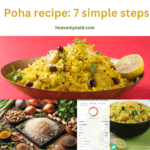Poha is a popular Indian breakfast dish made with flattened rice (flattened rice flakes). It’s a quick and easy dish that is not only delicious but also nutritious. Here’s a basic recipe for making traditional Maharashtrian style Poha; Poha recipe: 7 simple steps. 1.Poha Ingredients .2. poha recipe Instructions 3.Calories in poha 4. Poha nutrition 5. Poha, benefits 6.Is poha good for weight loss 7.calories in 1 plate poha
1.Poha recipe: 7 simple steps. Poha Ingredients
Poha recipe: 7 simple steps Poha ingredients is as follows;
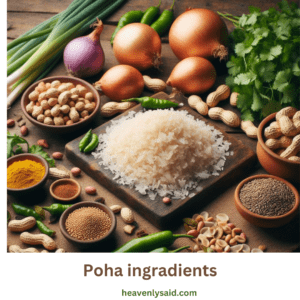
- 2 cups flattened rice (poha)
- 1 large onion, finely chopped
- 1-2 green chilies, finely chopped
- 1/4 cup peanuts
- 1/2 teaspoon mustard seeds
- 1/2 teaspoon cumin seeds
- A pinch of asafetida (Hing)
- 8-10 curry leaves
- 1/2 teaspoon turmeric powder
- Salt to taste
- 1-2 tablespoons oil
- Fresh coriander leaves for garnish
- Lemon wedges for serving (optional)
2. Poha recipe: 7 simple steps. Poha recipe Instructions:
- Wash Poha:
- Rinse the flattened rice (poha) in a sieve or colander under running water. Be gentle to avoid breaking the rice. Let it sit to drain excess water.
- Prepare Vegetables:
- Heat the oil in pan with medium flame. Add mustard seeds and cumin seeds. Once they splutter, add asafetida and curry leaves.
- Sauté Vegetables:
- Add chopped onions, green chilies, and peanuts. Sauté until the onions turn translucent.
- Seasoning:
- Sprinkle turmeric powder and salt over it & Mix well.
- Add Poha:
- Add the rinsed poha to the pan. make the lower flame of pan. Gently toss everything together until well combined. Cook the poha with medium flame heat thoroughly.
- Garnish:
- Garnish with fresh coriander leaves.
- Serve:
Serve hot with a side of lemon wedges if desired.
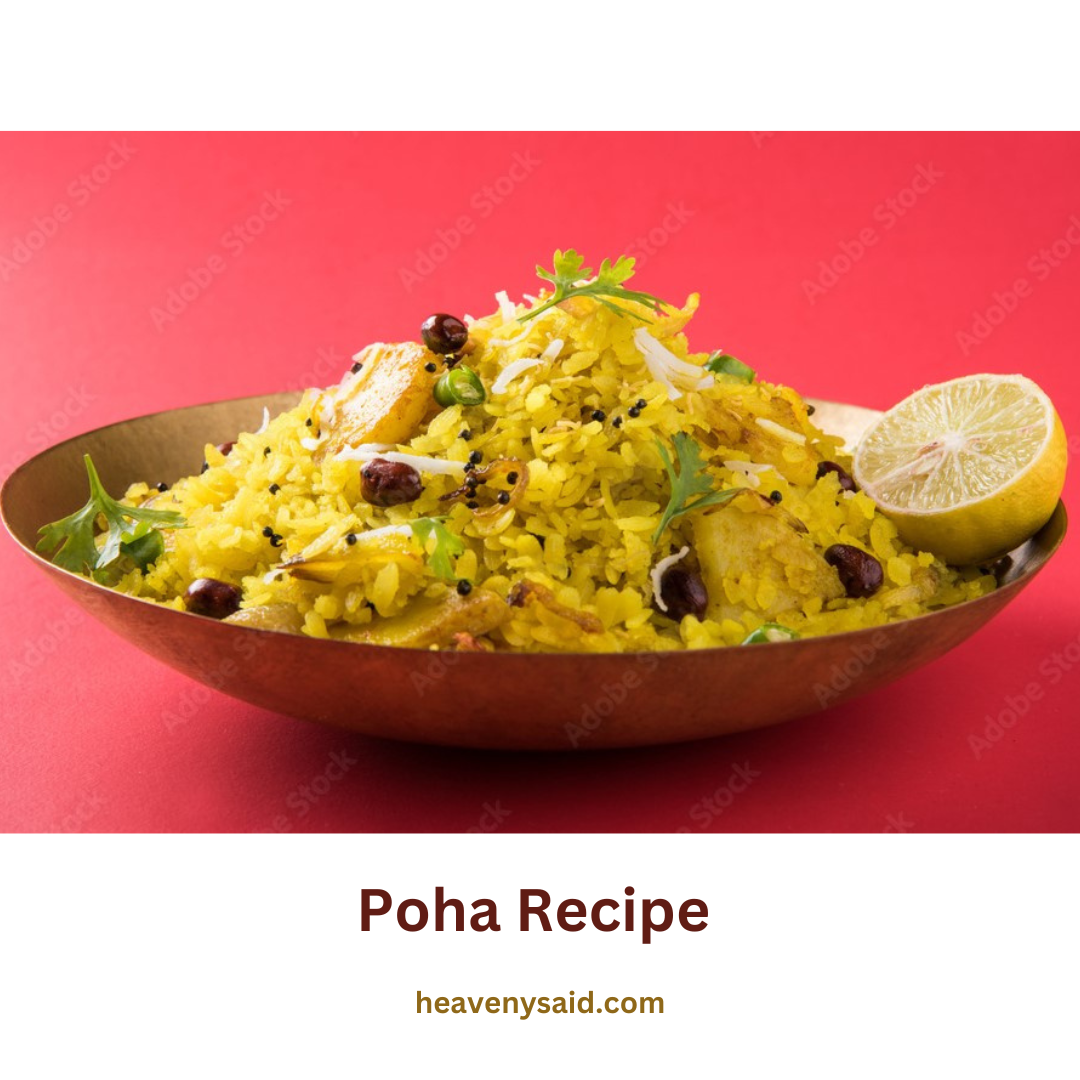
3.Poha recipe: 7 simple steps: Calories in poha
Calories in poha; Poha recipe: 7 simple steps is discussed as follows;
The caloric content in a serving of Poha can vary based on specific ingredients and portion sizes. However, I can provide a rough estimate for a basic Poha recipe. Keep in mind that these values are approximate and can vary based on the actual ingredients used and their quantities.
In a standard serving size of around 1 cup (approximately 250 grams) of Poha prepared with vegetables and oil, you might find:
- Calories: Around 200-250 calories
- Protein: 5-7 grams
- Carbohydrates: 30-35 grams
- Fat: 7-10 grams
These values can vary based on factors like the amount of oil used, additional ingredients, and individual variations in recipes. If you’re looking for precise nutritional information, it’s best to calculate it based on the specific ingredients and quantities you use.

4. Poha recipe: 7 simple steps ; Poha nutrition
The nutritional content of Poha can vary based on the specific ingredients and proportions used in the recipe. Here’s a general overview of the nutritional components in 1 cup (about 250 grams) of Poha prepared with vegetables:
- Calories: Approximately 200-250 kcal
- Protein: Around 5-7 grams
- Carbohydrates: Roughly 30-35 grams
- Fat: About 7-10 grams
- Dietary Fiber: 2-3 grams
- Sugar: 1-2 grams
- Vitamins and Minerals: Poha is a good source of iron, phosphorus, and B vitamins.
Keep in mind that these values are approximate and can vary based on the specific ingredients used in your Poha recipe. Additionally, the nutritional content may be influenced by factors such as the amount of oil used, the presence of additional ingredients like peanuts or vegetables, and individual variations in recipes. If you have specific dietary concerns or requirements, it’s advisable to calculate the nutritional information based on the exact ingredients and quantities you use.
5. Poha recipe: Poha benefits
A traditional Indian dish made with flattened rice, offers several health benefits:
- Rich in Carbohydrates: Poha is a good source of complex carbohydrates, providing sustained energy and helping to maintain blood sugar levels.
- Low in Calories: Poha is relatively low in calories, making it a suitable choice for those looking to manage their weight.
- Dietary Fiber: It contains dietary fiber, aiding digestion and promoting a feeling of fullness, which can be beneficial for weight management.
- Gluten-Free: Poha is naturally gluten-free, making it a safe option for individuals with gluten sensitivity or celiac disease.
- Protein Content: While not extremely high in protein, Poha does contain some protein, contributing to overall nutrient intake.
- Rich in Iron: Poha can be a good source of iron, especially if it’s prepared with ingredients like peas and potatoes, helping prevent iron deficiency anemia.
- Vitamins and Minerals: It provides essential vitamins and minerals, including B vitamins (B1, B2, B3, B6) and minerals like phosphorus.
- Easy to Digest: The flattened rice in Poha is easy to digest, making it a suitable option for breakfast or a light meal.
- Versatile: Poha is a versatile dish that can be customized with various vegetables, spices, and toppings, adding nutritional diversity to the diet.
- Culinary Adaptability: Poha can be easily prepared with regional variations, allowing for the inclusion of locally available and seasonal ingredients.
It’s important to note that while Poha has several health benefits, the overall nutritional profile can be influenced by the specific ingredients and cooking methods used in the recipe. For the healthiest preparation, consider incorporating a variety of vegetables and using minimal oil.
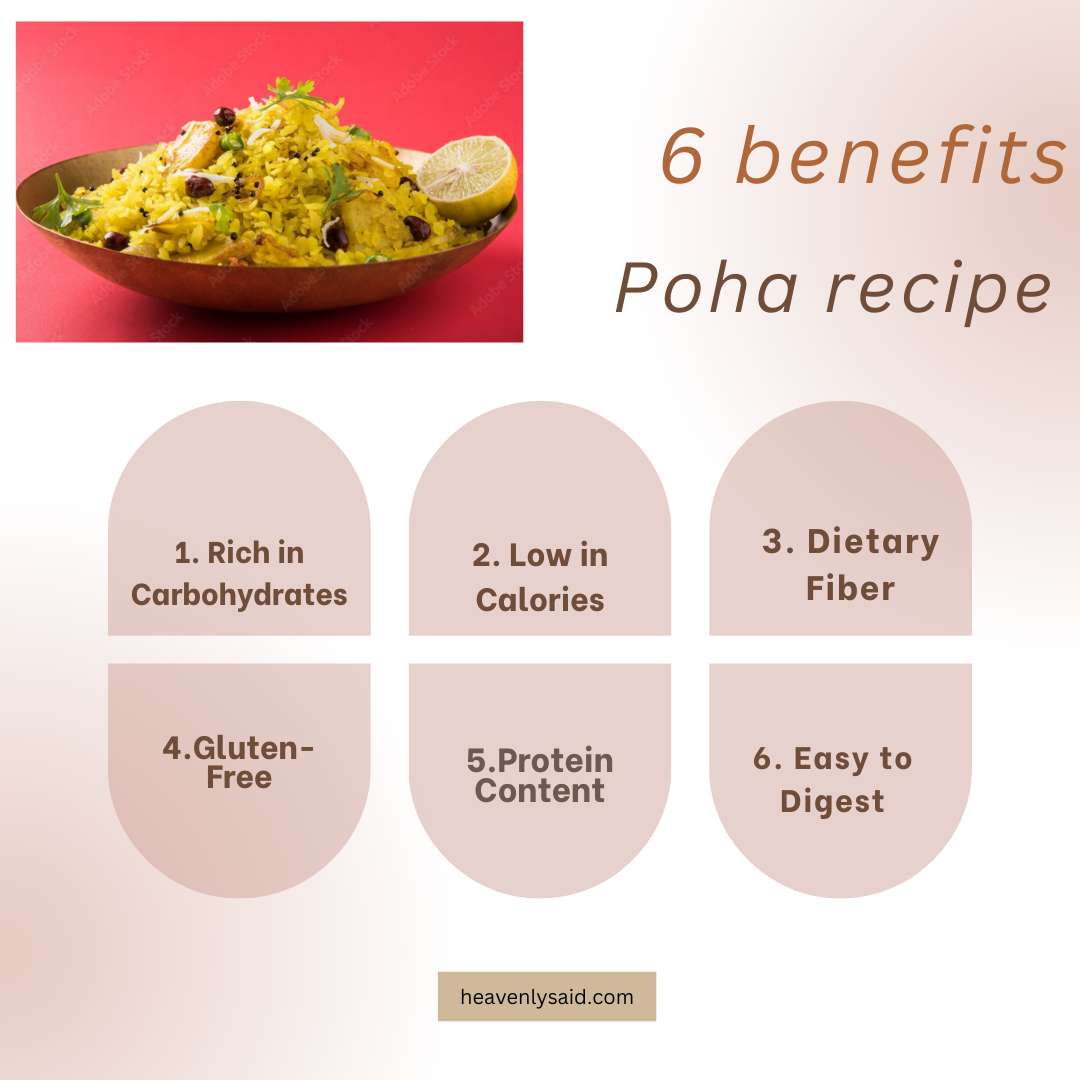
6. Poha recipe: Is poha good for weight loss
Yes, Poha can be a good option for individuals aiming for weight loss. Here are a few reasons why:
- Low in Calories: Poha is relatively low in calories, making it a suitable choice for those looking to manage their caloric intake.
- Complex Carbohydrates: Poha is a good source of complex carbohydrates, providing a steady release of energy. This can help in maintaining energy levels and preventing excessive hunger between meals.
- Dietary Fiber: Poha contains dietary fiber, which contributes to a feeling of fullness. Foods high in fiber can help control appetite and reduce overall calorie intake.
- Nutrient Density: While being low in calories, Poha still provides essential nutrients such as B vitamins, iron, and minerals, contributing to overall nutritional needs.
- Gluten-Free: Poha is naturally gluten-free, making it a suitable option for those with gluten sensitivities or celiac disease.
- Customizable: Poha can be prepared with a variety of vegetables, allowing for customization to include more nutrient-dense ingredients.
However, it’s essential to be mindful of the overall composition of your meal and portion sizes. For a weight-loss-friendly version:
- Use minimal oil for cooking.
- Include a variety of vegetables to boost the nutritional content.
- Be mindful of additional ingredients like nuts and seeds, as they can add calories.
- Monitor portion sizes to avoid overeating.
While Poha can be part of a balanced and healthy diet, it’s important to consider the overall dietary pattern and engage in regular physical activity for effective weight management. Always consult with a healthcare professional or a nutritionist for personalized advice based on your individual health needs and goals.
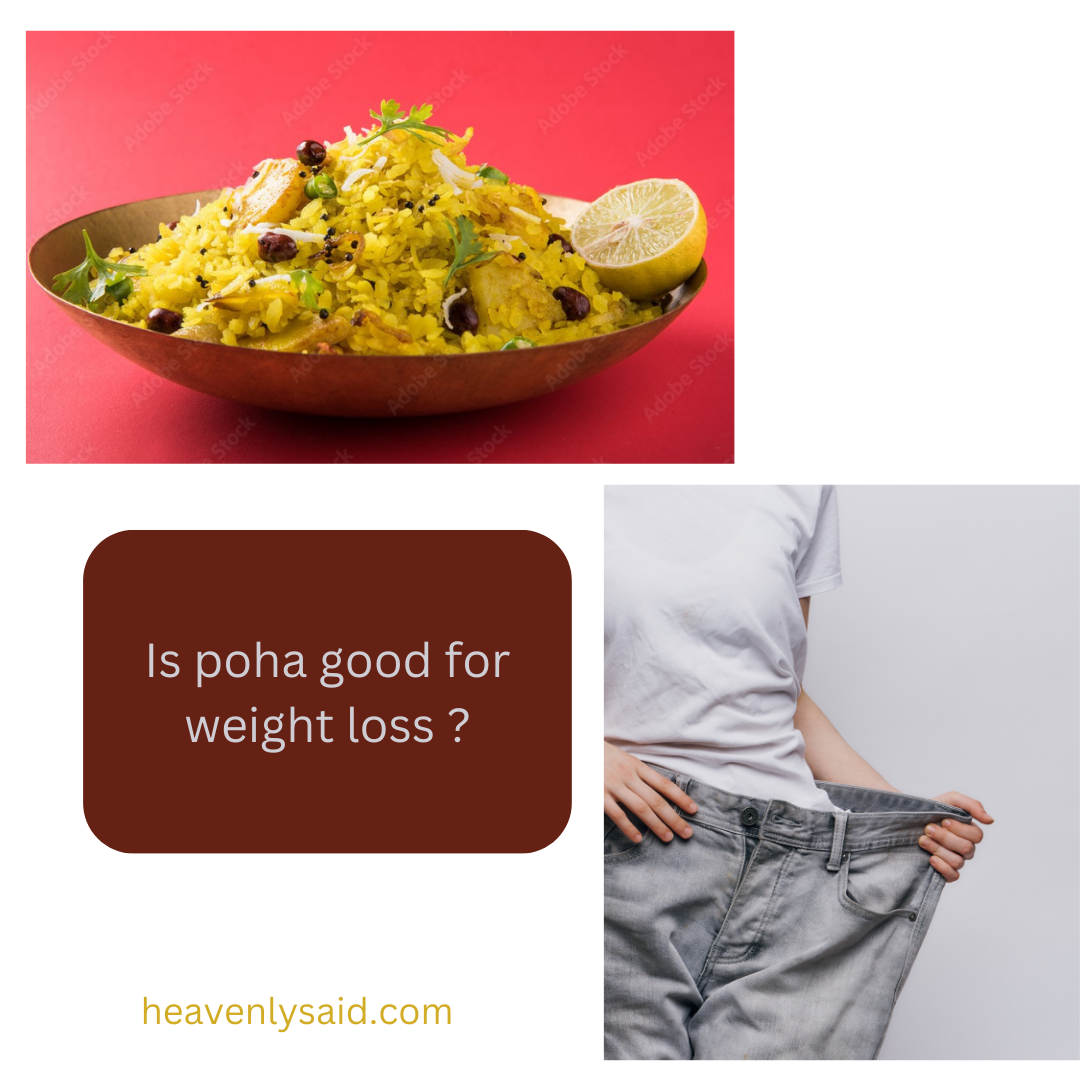
7. Poha recipe: calories in 1 plate poha
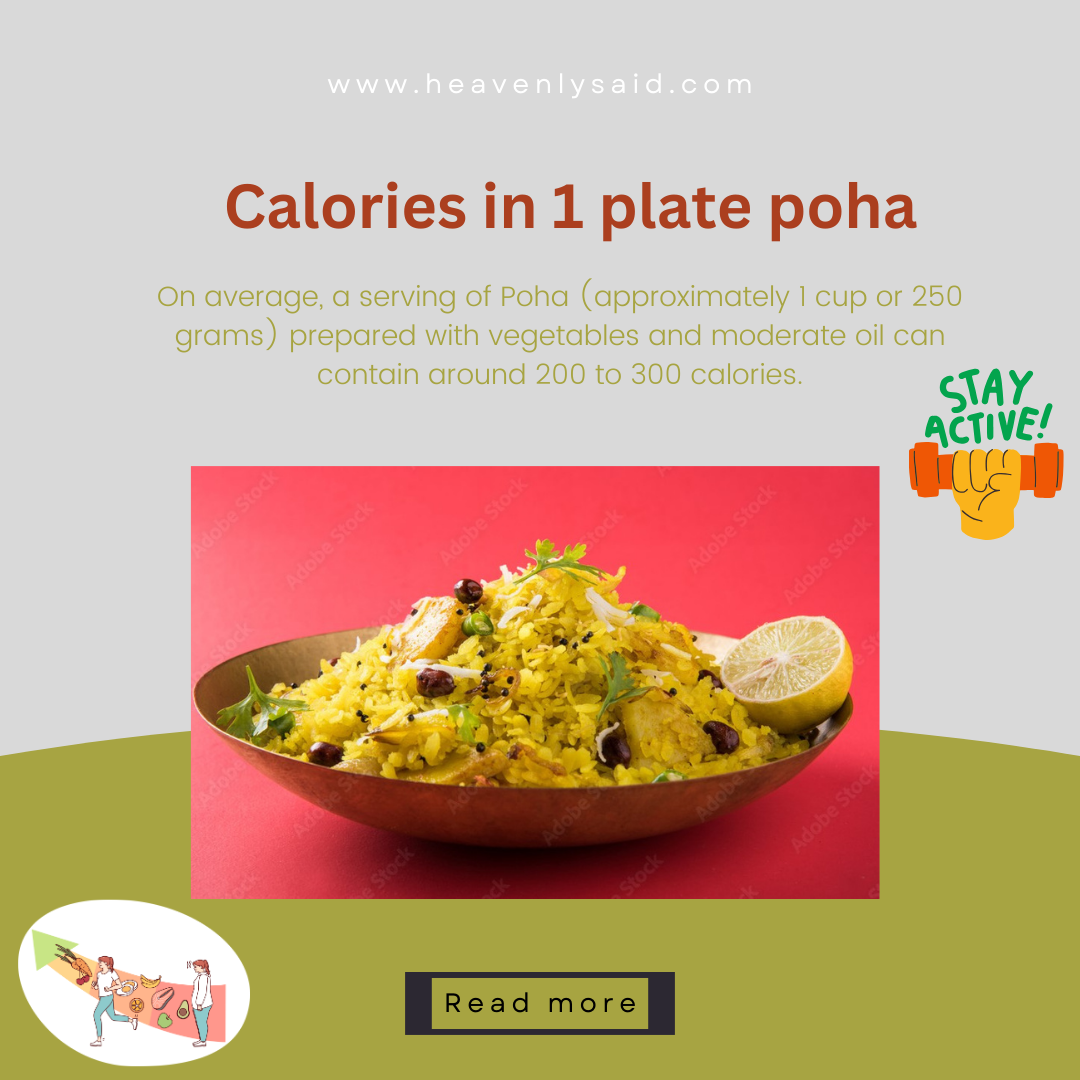
- The exact calorie content in a plate of Poha can vary based on factors such as the specific ingredients used, the portion size, and any additional toppings or condiments.
- On average, a serving of Poha (approximately 1 cup or 250 grams) prepared with vegetables and moderate oil can contain around 200 to 300 calories. This estimate includes the flattened rice, vegetables, and oil used in the preparation.
- If you have specific dietary concerns or are closely monitoring your calorie intake, it’s advisable to calculate the exact calories based on the ingredients and quantities you use. Additionally, consider any additional toppings, such as shev (fried gram flour noodles) or chutneys, as they can contribute to the overall calorie content of the dish.
Must visit: “Raising Thankful Kids: The Power of the 21-Day Gratitude Journal Adventure”
Must read; Simple remedies; how to stop hair fall immediately at home in 2024





